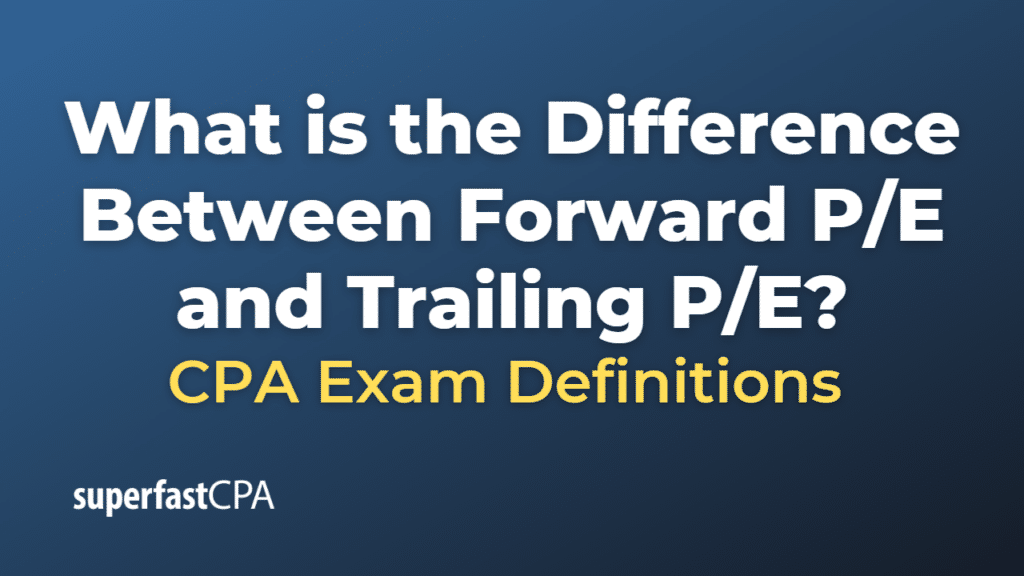Difference Between Forward P/E and Trailing P/E
The Price to Earnings (P/E) ratio is a commonly used financial metric that helps investors evaluate the valuation of a company. It’s calculated by dividing the market value per share (price) by the earnings per share (EPS). There are two main versions of this ratio, the forward P/E and the trailing P/E, which use different earnings data.
Trailing P/E
The trailing P/E ratio, also known as the “price to trailing earnings ratio”, uses the earnings per share (EPS) from the last four quarters (the trailing 12 months). Since it uses historical data, it’s based on actual, factual results, which means it’s a more certain measure. However, the downside is that it’s backward-looking and may not reflect changes in the company’s future earning potential.
Forward P/E
The forward P/E ratio, also known as the “price to future earnings ratio”, uses forecasted earnings per share for the next four quarters. These are typically provided by analysts or the company itself. Since it’s based on future earnings expectations, the forward P/E is a forward-looking metric and can give investors a sense of what they’re paying for future growth. However, the downside is that it relies on estimates, which may not always be accurate.
Key Differences
- Earnings Data: Trailing P/E uses past earnings data, while Forward P/E uses future earnings estimates.
- Indication: Trailing P/E provides a picture of how the company has been valued based on its past performance, while Forward P/E provides a picture of how the company is being valued based on its expected future performance.
- Certainty: Trailing P/E is based on actual, factual data, and thus, more certain. Forward P/E, on the other hand, is based on estimates, making it less certain and potentially more prone to error.
Both ratios have their strengths and weaknesses, and many investors will consider both when evaluating a stock. They are most useful when comparing similar companies in the same industry. It’s also important to compare these ratios to the broader market (e.g., the S&P 500 P/E ratio) and the historical P/E ratios of the same company.
Example of the Difference Between Forward P/E and Trailing P/E
Let’s consider a hypothetical tech company called “TechCo” to illustrate these concepts.
Trailing P/E
As of the end of the last fiscal year, TechCo reported earnings per share (EPS) of $5. The current market price of TechCo’s stock is $100. To calculate the trailing P/E, we would divide the current market price by the EPS.
Trailing P/E = Market Price / EPS = $100 / $5 = 20
So, TechCo’s trailing P/E ratio is 20. This means investors are willing to pay 20 times the last year’s earnings for each share of TechCo.
Forward P/E
Now, let’s say analysts predict that TechCo will have an EPS of $10 for the next fiscal year due to expected growth. The forward P/E would be calculated as:
Forward P/E = Market Price / Estimated Future EPS = $100 / $10 = 10
So, TechCo’s forward P/E ratio is 10. This means investors are willing to pay 10 times the estimated next year’s earnings for each share of TechCo.
Interpretation
In this case, TechCo’s forward P/E ratio is lower than its trailing P/E ratio, which could suggest that investors expect the company’s earnings to grow in the future. It’s important to note, though, that these are expectations, not certainties. If the expected earnings growth doesn’t materialize, the actual P/E ratio at the end of the next year may be different.
On the other hand, if TechCo’s forward P/E was higher than its trailing P/E, it could imply that the market expects earnings to shrink, or that the stock’s price is high relative to expected earnings, potentially indicating overvaluation.
Investors would typically compare TechCo’s P/E ratios with those of other similar companies and the market as a whole to decide whether TechCo’s stock is overvalued or undervalued. They would also consider other factors, such as the company’s growth prospects, financial health, competitive position, and macroeconomic conditions.













